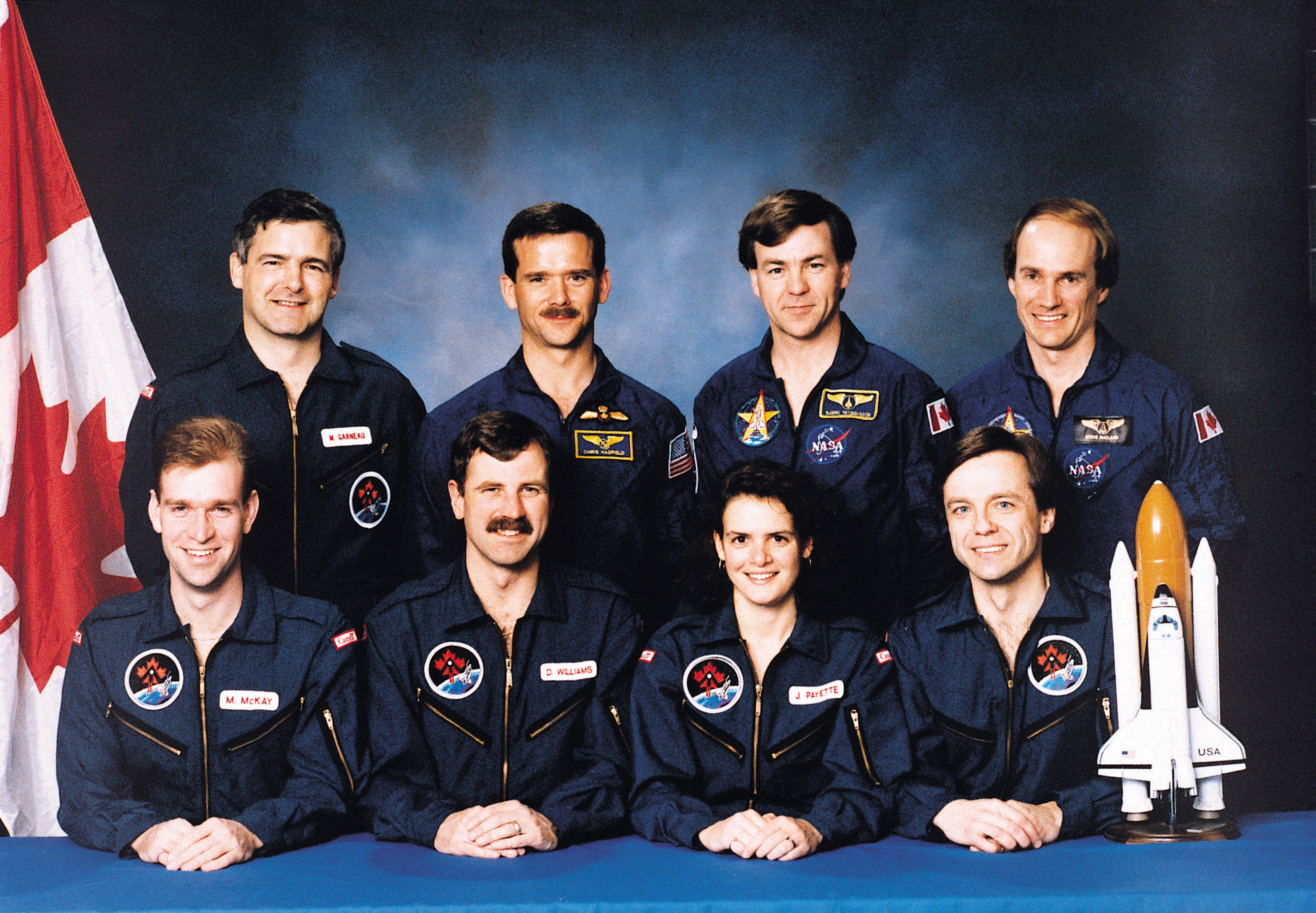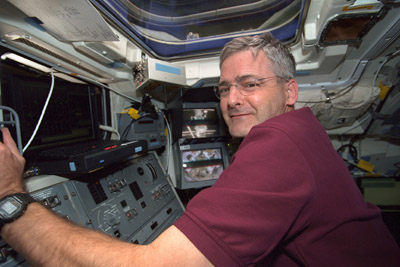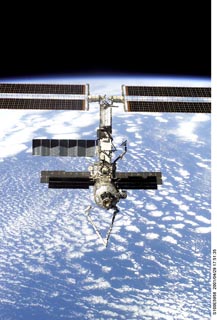An astronaut is an individual involved in flight beyond the Earth’s atmosphere. Since the National Research Council of Canada held its first recruitment campaign in 1983, 14 Canadians have completed astronaut training and nine have participated in 17 missions to space. Specifically, they have flown as payload specialists, mission specialists, and flight engineers on NASA shuttle flights and expeditions to the International Space Station (ISS). Canadian astronauts have played key roles in repairing satellites and building the ISS using the Canadarm and Canadarm2 robotic technologies, and have advanced scientific knowledge by conducting a variety of experiments in space. (See also Robotics in Canada; Space Technology.)
Background
Although the first Canadian-built satellite, Alouette 1, was launched in 1962, Canada’s participation in crewed space flight did not begin for another two decades. The Soviet Union and the United States pioneered space travel: Yuri Gagarin of the Soviet Union was the first person to ride an Earth-orbiting spacecraft, launched on 12 April 1961, and John Glenn became the first American to orbit the Earth on 20 February 1962.
First Canadian Astronauts
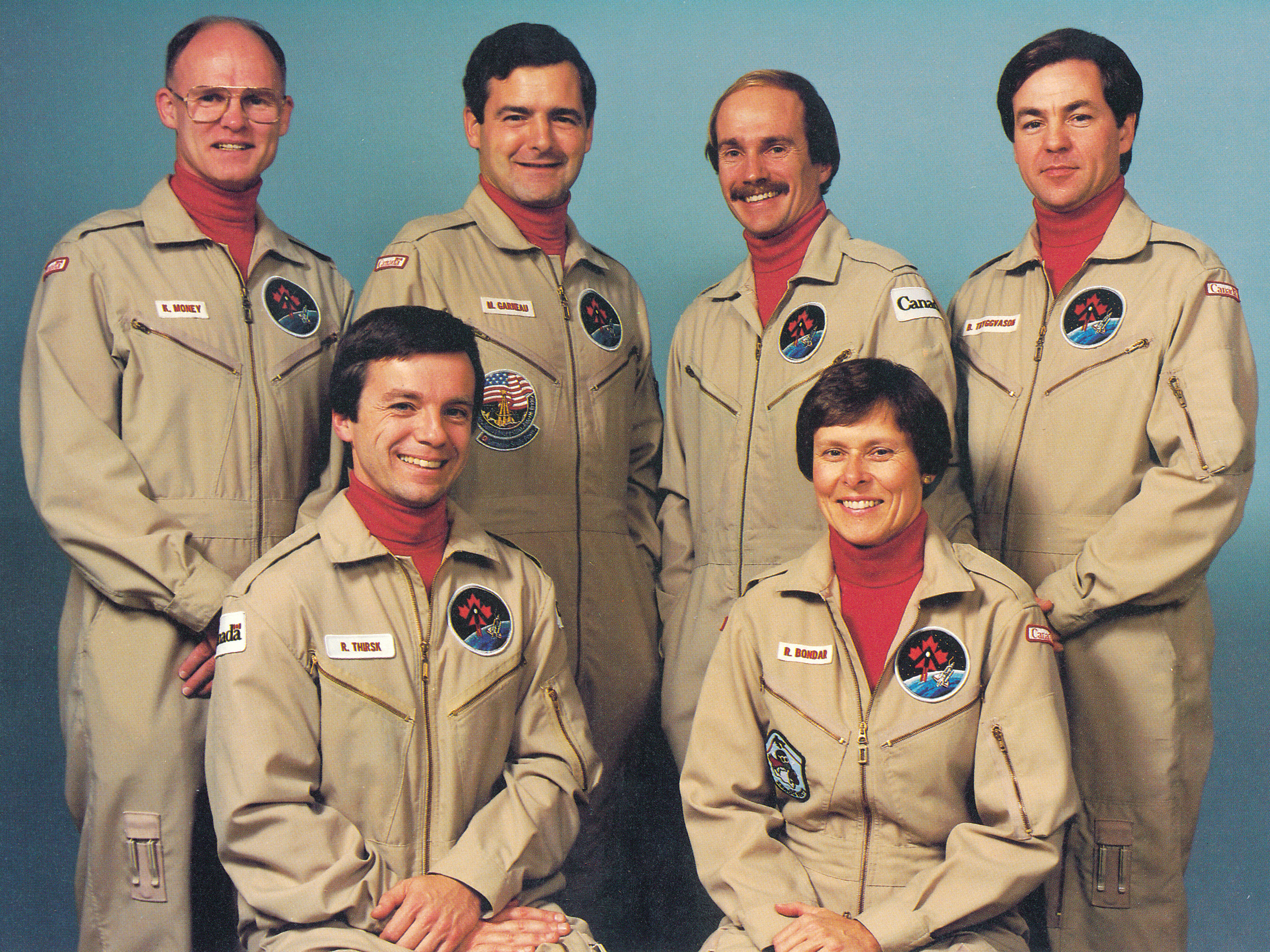
In October and November 1983, following an offer by NASA to fly Canadian astronauts as payload specialists on board the space shuttle Challenger, a screening committee from the National Research Council of Canada interviewed applicants. Six were selected: Ken Money, a physiologist, former Olympic athlete and jet pilot; Roberta Bondar, a neurologist, professor and former pilot; Marc Garneau, an electronics expert and commander with the Canadian Navy; Steve MacLean, a physicist and laser expert; Bob Thirsk, an engineer and medical doctor; and Bjarni Tryggvason, an aerodynamics and meteorology researcher.
Second Recruitment Campaign
Canada’s second group of astronauts was selected in June 1992, after a five-month selection process by the Canadian Space Agency. Four were chosen: Chris Hadfield, a Canadian Forces “top gun” working with the US Navy; Dave Williams, head of emergency services for a Toronto hospital; Julie Payette, a computer speech-recognition researcher with Bell-Northern Research (see Nortel); and Robert Stewart, a professor and geophysics researcher at the University of Calgary. Two weeks after being chosen, Stewart withdrew from the training program. He was replaced by Michael McKay, a Canadian Armed Forces captain specializing in computer engineering and robotics. In 1995, McKay left active astronaut duty for medical reasons, but he continued to work in the astronaut program, supporting Canadian shuttle flights until 1997.
Third Recruitment Campaign
In May 2008, the Canadian Space Agency launched a national recruitment campaign to find two new members of the Canadian Astronaut Corps to represent Canada on future space missions. The agency received 5,351 applications. On 13 May 2009, the space agency announced that Captain Jeremy Hansen, a fighter pilot from London, Ontario, and David Saint-Jacques, a physician from Saint-Lambert, Quebec, had been selected, bringing the number of Canadian astronauts to 12. They trained at the Canadian Space Agency before following the Astronaut Candidate Training program at NASA’s Johnson Space Center, from which they graduated in 2011. They were the first Canadian astronaut recruits since 1992.

Fourth Recruitment Campaign
The fourth recruitment campaign began in June 2016. The Canadian Space Agency received applications from 3,772 candidates representing every province and territory. Men accounted for 68.9 per cent of applicants, women 24 per cent, and 7.1 per cent chose not to declare their gender. The top 72 individuals from this group were selected to undergo aptitude tests that focused on strategic thinking and physical fitness. That group was narrowed down to 32 candidates, who were then tested on their ability to respond in emergency situations. Finally, a shortlist of 17 candidates completed a third round of tests to demonstrate their skills in robotics and communication, in addition to undergoing thorough medical evaluations.
In July 2017, the Canadian Space Agency announced Canada’s two newest astronaut trainees: Joshua Kutryk, an engineer, pilot and lieutenant-colonel in the Royal Canadian Air Force; and Jenni Gibbons, a mechanical engineer, combustion scientist and lecturer. They began NASA’s two-year Astronaut Candidate Training program that year and graduated in January 2020.

Criteria for Becoming an Astronaut
The Canadian Space Agency seeks outstanding scientists, engineers and/or medical doctors with a variety of backgrounds. To qualify to become an astronaut, candidates must demonstrate creativity, diversity, teamwork and a probing mind. Applicants must be Canadian citizens or residents of Canada, in excellent health with a high level of physical fitness, and hold degrees in medicine, engineering, science or applied sciences. Applicants with only baccalaureate degrees must also have at least two years of related professional experience. Candidates must meet physical restrictions in height (between 149.5 cm and 190.5 cm) and weight (between 50 kg and 95 kg).
Canadians in Space
1980s–1990s
In October 1984, Marc Garneau became the first Canadian in space on the space shuttle Challenger flight STS-41-G. As a payload specialist, he performed experiments on motion sickness in space and took measurements of the Earth’s atmosphere. He also conducted preliminary tests of the Canadian Space Vision System (SVS), a computerized imaging system designed to enhance control and operation of manipulators in space, including the shuttle’s Canadian-built robotic arm — the Canadarm.
Following a delay in shuttle flights for several years after the space shuttle Challenger exploded 73 seconds after liftoff in 1986, Roberta Bondar flew aboard the space shuttle Discovery (STS-42) in January 1992. She was the first Canadian woman and the first neurologist in space. Working as a payload specialist on behalf of scientists around the world, she conducted experiments in space physiology (i.e., how the human body functions in space) and materials processing in the European-built International Microgravity Laboratory module, carried in the shuttle’s payload bay.
In mid-1992, Chris Hadfield and Marc Garneau became the first Canadians to train as NASA mission specialists. Unlike payload specialists, whose primary role is to conduct scientific experiments, mission specialists are responsible for operating shuttle systems, including the Canadarm, and performing spacewalks. Only US astronauts were eligible for mission specialist training until 1992, when NASA opened the program to astronauts from the countries participating in building the ISS: Canada, Japan, and members of the European Space Agency.
In October 1992, Steve MacLean flew aboard Columbia as a payload specialist for STS-52. He conducted experiments in space physiology, atmospheric science and materials processing, but his primary goal was to test the first flight prototype of the SVS. The tests were so successful that NASA implemented the system in its space shuttle fleet. In 1995, the SVS would be used to attach the Orbiter Docking System to the Atlantis shuttle so it could dock with Russia’s Mir space station. An advancement on the SVS, the ASVS, was critical in constructing Canadarm2 and the Mobile Servicing System on the ISS.
In 1993, after nearly a year of basic training, Hadfield and Garneau became eligible for flight assignment. Hadfield flew aboard the space shuttle Atlantis (STS-74) in November 1995, becoming the first Canadian to fly as a mission specialist and the first to operate the Canadarm in space. He used it to position a Russian-built docking module that linked Atlantis to the Mir space station and allowed the two crews to visit each other’s spacecraft. Hadfield became the first Canadian to visit the Russian space station. (See also Hadfield Prepares for Space.)

Marc Garneau returned to space in May 1996 as a mission specialist on the space shuttle Endeavor (STS-77), becoming the first Canadian to fly two shuttle missions. He carried out a series of Canadian-sponsored scientific experiments and operated the Canadarm to retrieve a satellite from orbit.
Bob Thirsk flew as a payload specialist aboard the space shuttle Columbia (STS-78) in June 1996 and spent 17 days in space, the longest space journey for a Canadian at that time. With six crewmates, he performed 43 international experiments in life science and materials science, including studies of how the body responds to gravity.
In August 1997, Bjarni Tryggvason flew as the sole payload specialist for STS-85 aboard the Discovery. He tested a new anti-vibration system for payloads called the Microgravity Vibration Isolation Mount (MIM). The trial was successful, and the Canadian innovation was later adapted for installation on the ISS.
Dave Williams, the third Canadian chosen for mission specialist training in January 1995, served in this role aboard the Columbia (STS-90) in 1998. During the 16-day flight, the seven-person crew conducted 26 life science experiments as both experiment subjects and operators. The experiments were dedicated to the advancement of neuroscience research and focused on the effects of microgravity on the brain and nervous system.
Julie Payette flew on the space shuttle Discovery in 1999 as a mission specialist for STS-96. She and the other crew members were the first to dock the shuttle to the ISS. They also delivered four tons of equipment, and Payette became the first Canadian to board the station. (See also Space Lab Under Construction.)
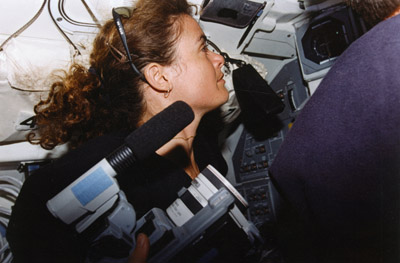
2000s–2010s
In November and December 2000, Marc Garneau flew to space for a third time, serving as a mission specialist for STS-97 aboard the Endeavour. A key objective of the mission, which spanned nearly 11 days, was to install solar arrays (large wing panels outfitted with solar power cells) on the ISS. Garneau used the Canadarm to attach these to the station. From within the shuttle, he then coordinated the activities of two of his crew members as they completed the installation on spacewalks. All systems on the ISS are now powered by the solar arrays installed on this mission.
In April and May 2001, Chris Hadfield served as a mission specialist for STS-100 aboard the Endeavour. The crew delivered and installed Canadarm2, the new Canadian-built robotic arm, on the ISS. (Unlike its predecessor, which left and returned to Earth with each space shuttle, Canadarm2 remains on the station.) Hadfield performed two spacewalks on this mission, becoming the first Canadian to leave a spacecraft and float freely in space.
In 2004, Bob Thirsk trained at the Yuri Gagarin Cosmonaut Training Centre near Moscow, certifying as a flight engineer for the Soyuz spacecraft.
Steve MacLean’s second assignment in outer space was as a mission specialist on the Atlantis shuttle (STS-115) in September 2006. He acted as flight engineer and robotics lead for the first mission to build the ISS after the fatal Columbia accident of 2003, in which the shuttle disintegrated as it returned to Earth (see Nasa’s Columbia Shuttle Disaster). MacLean became the first Canadian to operate Canadarm2 in space during the installation of solar array panels and supporting structures on the station. He also became the second Canadian to walk in space.
In 2007, Bob Thirsk undertook European capsule communicator training in Germany to support the European Space Agency’s Columbus Control Centre. The next year, he was assigned to Expedition 20/21 as a flight engineer. The expedition involved a six-month stay on board the ISS in the second half of 2009, making Thirsk the first Canadian to take part in a long-duration mission. He was responsible for maintaining and repairing the station, in addition to conducting scientific experiments.
In July 2009, Julie Payette flew on the Endeavour (STS-127) as a member of a mission that completed the construction of the Kibo Japanese Experiment Module on the ISS. Payette also operated three robotic arms during her two-week stay. July 2009 marked the first time two Canadians were in space at the same time, Thirsk having begun his ISS expedition several weeks earlier.
In December 2012, Hadfield departed on his third space mission, Expedition 34/35, serving first as flight engineer aboard the Soyuz spacecraft. During the second half of his five-month assignment, he became the first Canadian commander of the ISS. Among other duties, he helped berth the SpaceX Dragon cargo capsule using Canadarm2.
David Saint-Jacques embarked on his first mission, a 204-day mission on board the ISS, in December 2018. In addition to serving as co-pilot of the Soyuz spacecraft and flight engineer on Expedition 58/59, Saint-Jacques was tasked with performing scientific experiments, operating Canadarm2, going on spacewalks, acting as a crew medical officer and ensuring the proper function of the European Space Agency’s Columbus Laboratory. To date, Saint-Jacques’s 204 days in space is the longest mission of any Canadian astronaut.
2020s

On 3 April 2023, the Canadian Space Agency announced that Jeremy Hansen was assigned to the NASA-led Artemis II mission. Aboard NASA’s Orion spacecraft, which is scheduled to launch in September 2025, Hansen and three American astronauts will orbit around the Moon. As a member of the crew, Hansen will be the first Canadian astronaut to fly around the Moon. Jenni Gibbons will serve as backup astronaut for the mission.
On 22 November 2023, the Honourable François-Philippe Champagne, Minister responsible for the Canadian Space Agency, announced that Joshua Kutryk was assigned to a six-month mission on the ISS. Scheduled to take place in 2025, Kutryk will launch aboard the Boeing CST-100 Starliner spaceship. His participation will make him the first Canadian Space Agency astronaut to be part of NASA’s commercial crew program. He will also become the fourth Canadian Space Agency astronaut to participate in a long-duration mission aboard the ISS.

 Share on Facebook
Share on Facebook Share on X
Share on X Share by Email
Share by Email Share on Google Classroom
Share on Google Classroom
